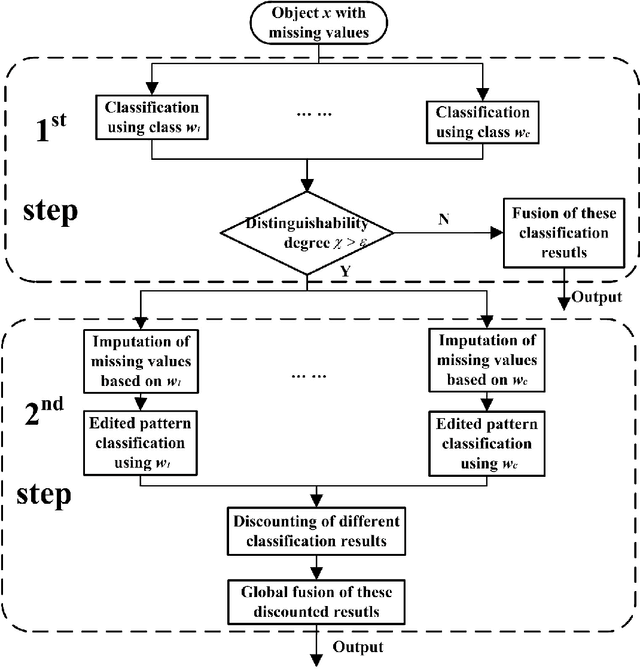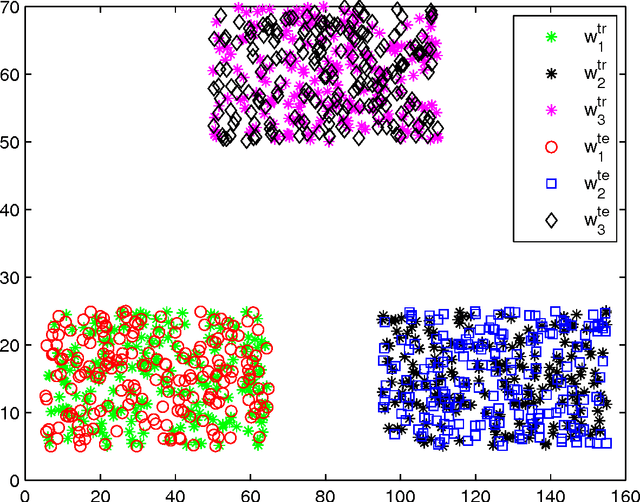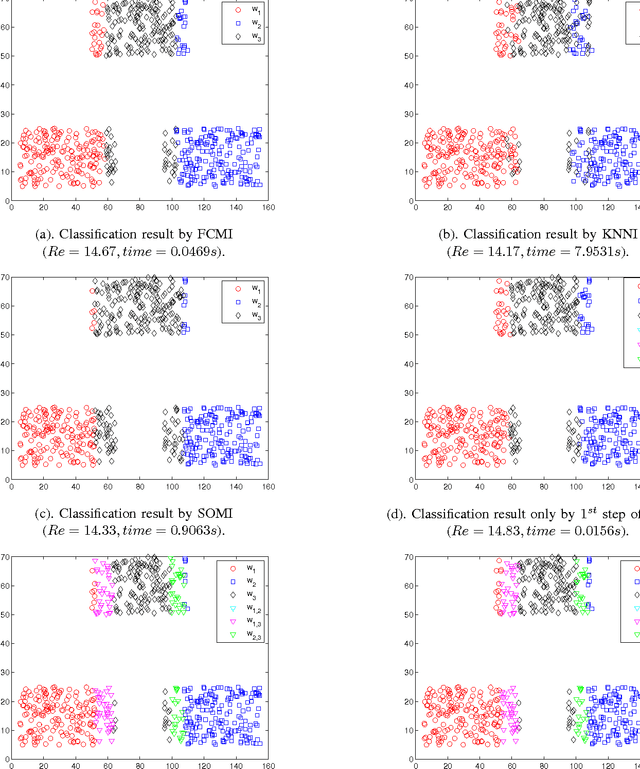Jean Dezert
Palaiseau
Quantum Conflict Measurement in Decision Making for Out-of-Distribution Detection
May 10, 2025Abstract:Quantum Dempster-Shafer Theory (QDST) uses quantum interference effects to derive a quantum mass function (QMF) as a fuzzy metric type from information obtained from various data sources. In addition, QDST uses quantum parallel computing to speed up computation. Nevertheless, the effective management of conflicts between multiple QMFs in QDST is a challenging question. This work aims to address this problem by proposing a Quantum Conflict Indicator (QCI) that measures the conflict between two QMFs in decision-making. Then, the properties of the QCI are carefully investigated. The obtained results validate its compliance with desirable conflict measurement properties such as non-negativity, symmetry, boundedness, extreme consistency and insensitivity to refinement. We then apply the proposed QCI in conflict fusion methods and compare its performance with several commonly used fusion approaches. This comparison demonstrates the superiority of the QCI-based conflict fusion method. Moreover, the Class Description Domain Space (C-DDS) and its optimized version, C-DDS+ by utilizing the QCI-based fusion method, are proposed to address the Out-of-Distribution (OOD) detection task. The experimental results show that the proposed approach gives better OOD performance with respect to several state-of-the-art baseline OOD detection methods. Specifically, it achieves an average increase in Area Under the Receiver Operating Characteristic Curve (AUC) of 1.2% and a corresponding average decrease in False Positive Rate at 95% True Negative Rate (FPR95) of 5.4% compared to the optimal baseline method.
Distances Between Partial Preference Orderings
Jul 29, 2024

Abstract:This paper proposes to establish the distance between partial preference orderings based on two very different approaches. The first approach corresponds to the brute force method based on combinatorics. It generates all possible complete preference orderings compatible with the partial preference orderings and calculates the Frobenius distance between all fully compatible preference orderings. Unfortunately, this first method is not very efficient in solving high-dimensional problems because of its big combinatorial complexity. That is why we propose to circumvent this problem by using a second approach based on belief functions, which can adequately model the missing information of partial preference orderings. This second approach to the calculation of distance does not suffer from combinatorial complexity limitation. We show through simple examples how these two theoretical methods work.
On Kenn's Rule of Combination Applied to Breast Cancer Precision Therapy
Mar 01, 2023Abstract:This short technical note points out an erroneous claim about a new rule of combination of basic belief assignments presented recently by Kenn et al. in 2023, referred as Kenn's rule of combination (or just as KRC for short). We prove thanks a very simple counter-example that Kenn's rule is not associative. Consequently, the results of the method proposed by Kenn et al. highly depends on the ad-hoc sequential order chosen for the fusion process as proposed by the authors. This serious problem casts in doubt the interest of this method and its real ability to provide trustful results and to make good decisions to help for precise breast cancer therapy.
Adaptive imputation of missing values for incomplete pattern classification
Feb 08, 2016



Abstract:In classification of incomplete pattern, the missing values can either play a crucial role in the class determination, or have only little influence (or eventually none) on the classification results according to the context. We propose a credal classification method for incomplete pattern with adaptive imputation of missing values based on belief function theory. At first, we try to classify the object (incomplete pattern) based only on the available attribute values. As underlying principle, we assume that the missing information is not crucial for the classification if a specific class for the object can be found using only the available information. In this case, the object is committed to this particular class. However, if the object cannot be classified without ambiguity, it means that the missing values play a main role for achieving an accurate classification. In this case, the missing values will be imputed based on the K-nearest neighbor (K-NN) and self-organizing map (SOM) techniques, and the edited pattern with the imputation is then classified. The (original or edited) pattern is respectively classified according to each training class, and the classification results represented by basic belief assignments are fused with proper combination rules for making the credal classification. The object is allowed to belong with different masses of belief to the specific classes and meta-classes (which are particular disjunctions of several single classes). The credal classification captures well the uncertainty and imprecision of classification, and reduces effectively the rate of misclassifications thanks to the introduction of meta-classes. The effectiveness of the proposed method with respect to other classical methods is demonstrated based on several experiments using artificial and real data sets.
Uniform and Partially Uniform Redistribution Rules
Jul 21, 2011
Abstract:This short paper introduces two new fusion rules for combining quantitative basic belief assignments. These rules although very simple have not been proposed in literature so far and could serve as useful alternatives because of their low computation cost with respect to the recent advanced Proportional Conflict Redistribution rules developed in the DSmT framework.
* 4 pages; "Advances and Applications of DSmT for Plausible and Paradoxical reasoning for Information Fusion", International Workshop organized by the Bulgarian IST Centre of Competence in 21st Century, December 14, 2006, Bulg. Acad. of Sciences, Sofia, Bulgaria
Threat assessment of a possible Vehicle-Born Improvised Explosive Device using DSmT
Aug 02, 2010



Abstract:This paper presents the solution about the threat of a VBIED (Vehicle-Born Improvised Explosive Device) obtained with the DSmT (Dezert-Smarandache Theory). This problem has been proposed recently to the authors by Simon Maskell and John Lavery as a typical illustrative example to try to compare the different approaches for dealing with uncertainty for decision-making support. The purpose of this paper is to show in details how a solid justified solution can be obtained from DSmT approach and its fusion rules thanks to a proper modeling of the belief functions involved in this problem.
* 26 pages
A two-step fusion process for multi-criteria decision applied to natural hazards in mountains
May 06, 2010



Abstract:Mountain river torrents and snow avalanches generate human and material damages with dramatic consequences. Knowledge about natural phenomenona is often lacking and expertise is required for decision and risk management purposes using multi-disciplinary quantitative or qualitative approaches. Expertise is considered as a decision process based on imperfect information coming from more or less reliable and conflicting sources. A methodology mixing the Analytic Hierarchy Process (AHP), a multi-criteria aid-decision method, and information fusion using Belief Function Theory is described. Fuzzy Sets and Possibilities theories allow to transform quantitative and qualitative criteria into a common frame of discernment for decision in Dempster-Shafer Theory (DST ) and Dezert-Smarandache Theory (DSmT) contexts. Main issues consist in basic belief assignments elicitation, conflict identification and management, fusion rule choices, results validation but also in specific needs to make a difference between importance and reliability and uncertainty in the fusion process.
Importance of Sources using the Repeated Fusion Method and the Proportional Conflict Redistribution Rules #5 and #6
Apr 09, 2010Abstract:We present in this paper some examples of how to compute by hand the PCR5 fusion rule for three sources, so the reader will better understand its mechanism. We also take into consideration the importance of sources, which is different from the classical discounting of sources.
Tracking object's type changes with fuzzy based fusion rule
Oct 08, 2009Abstract:In this paper the behavior of three combinational rules for temporal/sequential attribute data fusion for target type estimation are analyzed. The comparative analysis is based on: Dempster's fusion rule proposed in Dempster-Shafer Theory; Proportional Conflict Redistribution rule no. 5 (PCR5), proposed in Dezert-Smarandache Theory and one alternative class fusion rule, connecting the combination rules for information fusion with particular fuzzy operators, focusing on the t-norm based Conjunctive rule as an analog of the ordinary conjunctive rule and t-conorm based Disjunctive rule as an analog of the ordinary disjunctive rule. The way how different t-conorms and t-norms functions within TCN fusion rule influence over target type estimation performance is studied and estimated.
Comments on "A new combination of evidence based on compromise" by K. Yamada
Jun 28, 2009Abstract:Comments on ``A new combination of evidence based on compromise'' by K. Yamada
 Add to Chrome
Add to Chrome Add to Firefox
Add to Firefox Add to Edge
Add to Edge